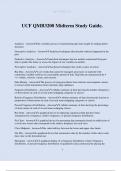Opdrachten: niet verplicht, toepassingen op geziene leerstof.
INHOUD
2 Globalizing business ....................................................................................................................................... 3
2.1 Inleiding ................................................................................................................................................. 3
2.2 European and Global Business .............................................................................................................. 3
2.3 A unified framework .............................................................................................................................. 7
2.3.1 Institutionele perspectief .............................................................................................................. 7
2.3.2 Resource-based view .................................................................................................................... 7
2.4 Understanding globalization .................................................................................................................. 8
2.4.1 Trends in globalization .................................................................................................................. 8
2.4.2 What is globalization..................................................................................................................... 9
2.4.3 A glance at the global economy .................................................................................................. 10
2.4.4 Implications for practice ............................................................................................................. 10
3 Formal institutions: political, economic and legal systems ........................................................................... 11
3.1 Inleiding ............................................................................................................................................... 11
3.2 An institution-based view of international business ........................................................................... 12
3.2.1 What do institutions do? ............................................................................................................ 12
3.2.2 Two core propositions ................................................................................................................ 13
3.3 Political systems .................................................................................................................................. 13
3.3.1 Why is it important for business? ............................................................................................... 14
3.4 Economische systemen ....................................................................................................................... 15
3.4.1 Markteconomie .......................................................................................................................... 15
3.4.2 Vraageconomie ........................................................................................................................... 16
3.4.3 Variaties van kapitalisme ............................................................................................................ 16
3.5 Legale systemen .................................................................................................................................. 17
3.5.1 Civil law and common law .......................................................................................................... 18
3.5.2 Legal processes ........................................................................................................................... 19
3.6 Debates and extentions ....................................................................................................................... 19
3.6.1 Property rights ............................................................................................................................ 19
3.6.2 Corporate governance ................................................................................................................ 20
3.6.3 Institutions and political risk ....................................................................................................... 21
3.7 Case repsol........................................................................................................................................... 21
3.8 Opdrachtvraag: aantal landen bezocht sinds je 12de ........................................................................... 21
4 informal instituions: culture, religion and laguages ...................................................................................... 22
1
, 4.1 Recap: instituties ................................................................................................................................. 22
4.1.1 Elementen van informele instituties ........................................................................................... 22
4 Identifying and assessing firm resources ...................................................................................................... 26
4.1 Resource Based VIew........................................................................................................................... 26
4.2 Identifying resources ........................................................................................................................... 27
4.2.1 Primary resources ....................................................................................................................... 27
4.2.2 Capabilities .................................................................................................................................. 28
4.3 Appraising resources: the VRIO framework ........................................................................................ 30
4.4 Applying resource analysis: benchmarking ......................................................................................... 31
4.4.1 Benchmarking as an analytical tool ............................................................................................ 31
4.4.2 Application: outsourcing and offshoring .................................................................................... 32
4.5 Debates and extentions ....................................................................................................................... 33
4.5.1 Long-term consequences of outsourcing ................................................................................... 33
4.5.2 Long-term competition with dynamic capabilities ..................................................................... 34
4.6 Harvard Business case ......................................................................................................................... 34
6 Investing abroad directly & CH11 ................................................................................................................. 36
6.1 FDI ........................................................................................................................................................ 37
6.1.1 Horizontale DBI ........................................................................................................................... 37
6.1.2 Verticale DBI ............................................................................................................................... 38
6.1.3 FDI: good or bad for host nations? ............................................................................................. 38
6.2 Alternatives: contractual expansion modes ........................................................................................ 39
6.2.1 Exporteren .................................................................................................................................. 39
6.2.2 Licensing and franchising ............................................................................................................ 40
6.3 Waarom bestaan dit soort multinationale ondernemingen? .............................................................. 40
6.3.1 Ownership Advantage (OA) ........................................................................................................ 41
6.3.2 Location advantage ..................................................................................................................... 42
6.3.3 Internalization advantage ........................................................................................................... 42
6.4 OLI paradigma vs internationalization process models ....................................................................... 43
6.5 IP models vs born globals .................................................................................................................... 44
12 foreign entry strategies ............................................................................................................................ 45
12.1 Why expand abroad?........................................................................................................................... 45
12.2 Where to expand to? ........................................................................................................................... 46
12.3 When to expand? ................................................................................................................................ 47
12.4 How to expand? ................................................................................................................................... 48
13 Competitive Dynamics ............................................................................................................................. 51
14 Global Strategies and acquisitions ........................................................................................................... 57
15 CH15: Organizing and innovating in the MNE .......................................................................................... 57
2
,1 GLOBALIZING BUSINESS
Sels
1.1 INLEIDING
Internationale bedrijven Bedrijf/firma die zich engageert in internationale economische
activiteiten of handel drijft in het buitenland.
Globale bedrijven Bedrijfsvoering over de wereld met zowel internationale (cross-
border) activiteiten als landelijke (domestic) bedrijfsactiviteiten.
Multinationale onderneming MNE Firma die zich engageert in buitenlandse directe investeringen.
Multinational enterprise
Buitenlandse Directe Investering FDI Investeren in, controleren en managen van activiteiten die
Foreign Direct Investment toegevoegde waarde creëren in het buitenland.
Essentieel aan FDI: controleren en managen.
→ Filialen opstarten = FDI
→ Franchising, licensing ≠ FDI want geen controle en managing; = buitenlandse entry mode
Belangrijke economische begrippen
Gross National Product (GNP) De som van toegevoegde waarde door bedrijven, huishoudens en de
Bruto Nationaal Product (BNP) overheid van een land.
= alles wat in een land geproduceerd wordt, ook door buitenlandse
bedrijven.
Gross Domestic Product (GDP) Totale marktwaarde van alle finale goederen en diensten
geproduceerd binnen een bepaald land, in een gegeven tijdsperiode
Bruto Binnenlands Product (BBP)
(meestal een kalenderjaar).
Gross National Income (GNI) = GDP + inkomen van de non-resident middelen in het buitenland.
Bruto Nationaal Inkomen (BNI)
Purchasing Power Parity (PPP) De aanpassing van het BBP om de verschillen in de cost of living te
reflecteren.
Koopkrachtpariteit (KKP)
In het ene land kan je meer consumeren dan in het andere met
eenzelfde budget.
→ geeft de werkelijke wisselkoers weer, niet enkel die van de munt
Link tussen het inkomen en de levensverwachting stijgt.
Link tussen de levensverwachting en het aantal kinderen daalt: de ongelijkheid is aan het afnemen in de
wereld.
1.2 EUROPEAN AND GLOBAL BUSINESS
• International business gaat over
(1) bedrijven die zich engageren in internationale (cross-border) economische activiteiten
(2) de activiteit van het buitenlandse zakendoen
o Wereldwijde issues die relevant zijn voor de Europese bedrijven en managers worden behandeld
met een focus op:
▪ Business in naaste landen
▪ EU instituties
3
, ▪ SMEs
▪ Onderzoek door Europese scholieren over deze onderwerpen
o Gaat verder dan ontwikkelde economieën door aandacht te geven aan emerging markets
Figuur 1.1: de meeste bedrijven/landen beginnen te doen aan im-/export
• Binnenlandse markt van Europese landen is kleiner → IB (international business) is belangrijk
• Vele bedrijfsvoering gebeurt met aangrenzende landen
• Meer dan 50% van de internationale activiteiten van EU landen gebeurt met andere EU lidstaten
Grafiek: ± 30% van wat geproduceerd wordt, wordt internationaal verhandeld.
4










